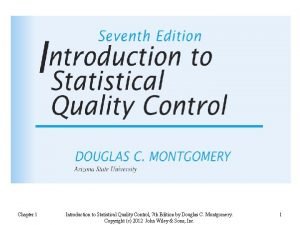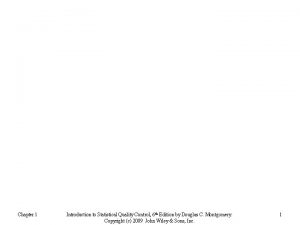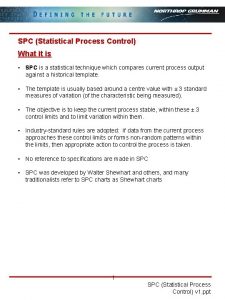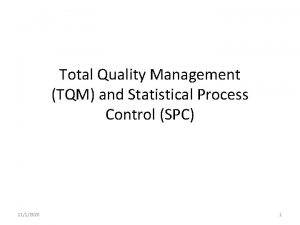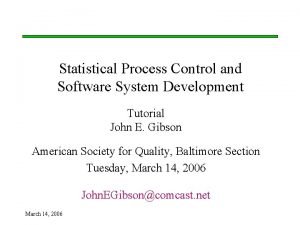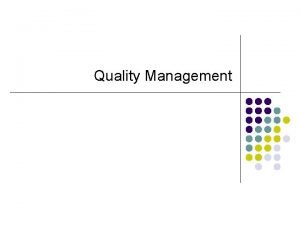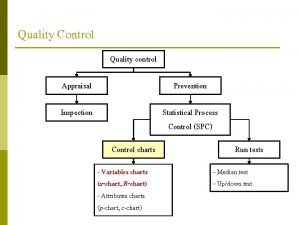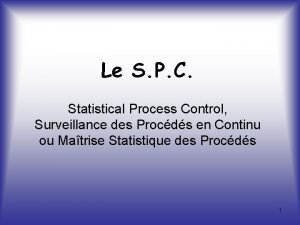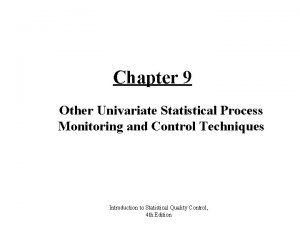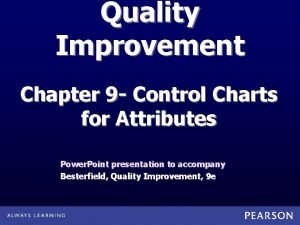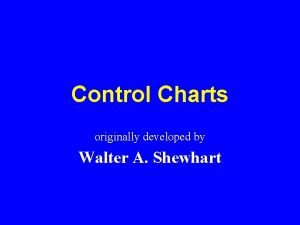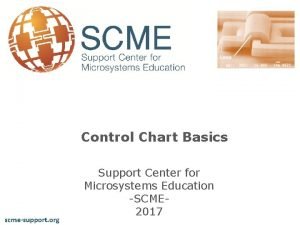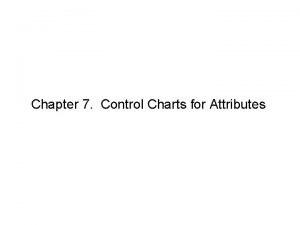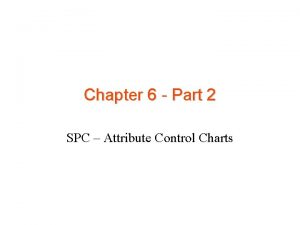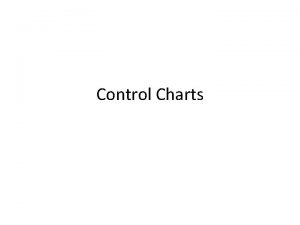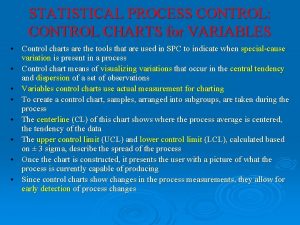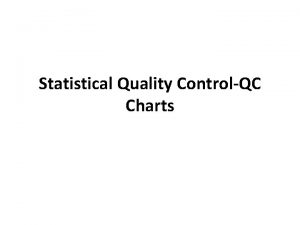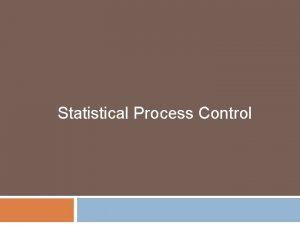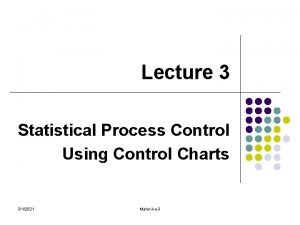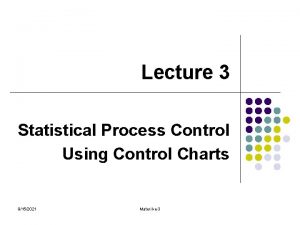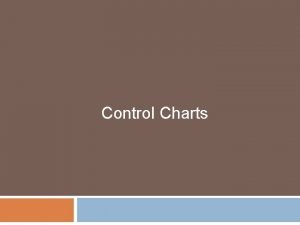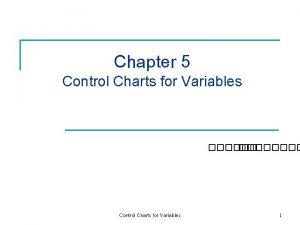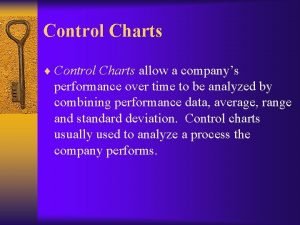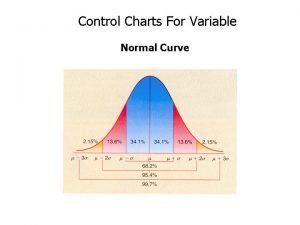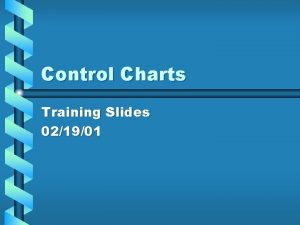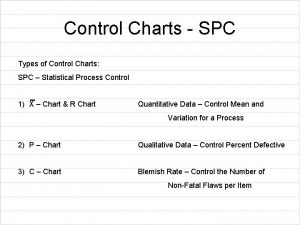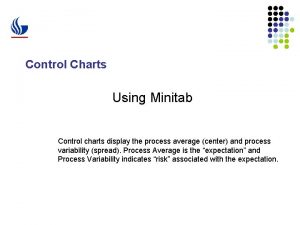Control Charts An Introduction to Statistical Process Control















- Slides: 15

Control Charts An Introduction to Statistical Process Control

Course Content • • • • Prerequisites Course Objectives What is SPC? Control Chart Basics Out of Control Conditions SPC vs. SQC Individuals and Moving Range Chart Central Limit Theorem X-bar and Range Charts Advanced Control Charts Attribute Charts Final Points Reference Section http: //www. biz-pi. com Control Charts

Prerequisites • Learners should be familiar with the following concepts prior to taking this course – Variation – Mean and Standard Deviation – Histograms – Normal Distributions – Cp and Cpk • Capability Course is available on BPI website if you need to review these topics http: //www. biz-pi. com Control Charts

Course Objectives • Upon completion of this course, participants should be able to: – Understand the basics of creating variable and attribute control charts – Understand the concepts of advanced control charting – Identify an out of control condition – Identify which control chart to use with each process – Calculate control limits for any control chart http: //www. biz-pi. com Control Charts

Real Life Examples • Process: Driving to Work • Average Time: 12 minutes • Standard Deviation: 2. 5 minutes • Common Causes – Wind speed, miss one green light, driving speed, number of cars on road, time when leaving house, rainy weather • Special Causes – Stop for school bus crossing, traffic accident, pulled over for speeding, poor weather conditions, car mechanical problems, construction detour, stoplights not working properly, train crossing http: //www. biz-pi. com Control Charts

Nelson Tests for Control A B ± 3σ 6 S 4 S ± 2σ 2 S ± 1σ C C B A http: //www. biz-pi. com UCL LCL ü Any point outside control limits ü 9 consecutive points on same side of centerline ü 6 consecutive points increasing or decreasing ü 2 of 3 points in same zone A or beyond ü 4 of 5 points in same zone B or beyond ü 14 consecutive points alternating up and down ü 15 consecutive points in either zone C ü 8 points in a row outside zone C, same side of centerline Control Charts

Nelson Test #3 +3σ +2σ +1σ 0 -1σ -2σ -3σ A UCL B C C CL B A LCL Rule 3: 6 consecutive points increasing or decreasing http: //www. biz-pi. com Control Charts

Individuals Chart UCL 6: 55 PM 0. 204 CL 9: 35 PM 0. 169 LCL http: //www. biz-pi. com Control Charts

Central Limit Theorem Number of Samples = 100 Number of Samples = 50 http: //www. biz-pi. com Number of Samples = 66 Number of Samples = 40 Control Charts

X-bar and R example AVERAGE Between Subgroup Variation http: //www. biz-pi. com VARIATION Within Subgroup Variation Control Charts

Range Chart 6: 55 PM 45 43 48 45 50 Range = 7 UCL CL 9: 35 PM 44 48 43 42 45 Range = 6 LCL Range = Max of Data Subgroup – Min of Data Subgroup http: //www. biz-pi. com Control Charts

How to setup EWMA chart • Determine λ (between 0 and 1) – λ is the proportion of current value used for calculating newest value – Recommend λ = 0. 10, 0. 20 or 0. 40 (use smaller λ values to detect smaller shifts) • Calculate new z values using λ = 0. 10 zi = λ*xi + (1 – λ) * zi-1 (where i = sample number) Sample Date x z 1 1 -Oct 9. 45 9. 945 2 2 -Oct 7. 99 9. 7495 3 3 -Oct 9. 29 9. 7035 4 4 -Oct 11. 66 9. 899 http: //www. biz-pi. com 9. 7495 = (0. 9*9. 945) + (0. 1*7. 99) 9. 899 = (0. 9*9. 7035) + (0. 1*11. 6) Control Charts

u chart • Plots the quantity of defects per part in a sample • Each part can have more than one defect • Use when sample size varies 11 total defects found on 6 documents http: //www. biz-pi. com u = 11/6 = 1. 833 defects per document whereas p = 4/6 = 67% defect rate Control Charts

Decision Tree for Control Charts What type of data: Attribute or Variable? Attribute Variable How are defects counted: Defectives (Y/N), or Count of Defects? Defectives How large are the subgroups? 1 Count Constant Sample Size? No Yes X-bar and Range X-bar and Std Dev No np chart P chart c chart u chart (number defective) (proportion defective) (defects per sample) (defects per unit) http: //www. biz-pi. com 5 or more Constant Sample Size? Individuals and Moving Range Yes 2 to 5 Control Charts

Additional Resources Business Performance Improvement http: //www. biz-pi. com Control Charts
 Introduction to statistical quality control montgomery
Introduction to statistical quality control montgomery Introduction to statistical quality control
Introduction to statistical quality control Statistical process control ppt
Statistical process control ppt Pengertian total quality management
Pengertian total quality management Statistical process control tutorial
Statistical process control tutorial Statistical process control
Statistical process control Statistical process control
Statistical process control 20%ของ300
20%ของ300 Controle spc
Controle spc Statistical process control
Statistical process control Process selection charts
Process selection charts How to calculate control limits
How to calculate control limits Who invented control charts
Who invented control charts Weco rules for control charts
Weco rules for control charts Attribute control charts
Attribute control charts Spc attribute control charts
Spc attribute control charts
